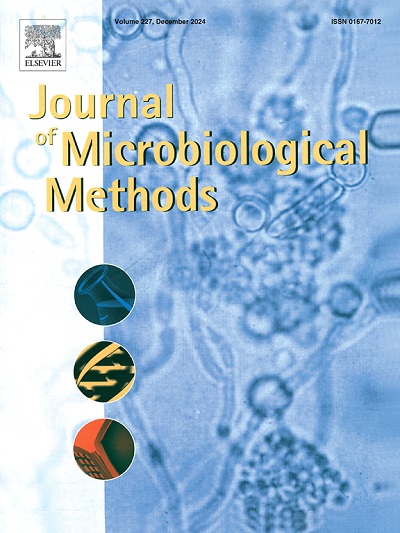微电解水联合紫外光有效灭活金黄色葡萄球菌治疗金黄色葡萄球菌所致小鼠皮肤脓肿
IF 1.9
4区 生物学
Q4 BIOCHEMICAL RESEARCH METHODS
引用次数: 0
摘要
在这项研究中,我们评估了微酸性电解水(SAEW)和紫外线c (UV) (SAEW + UV)在体内和体外对金黄色葡萄球菌(S. aureus)感染的联合效果,并特别关注了小鼠皮肤脓肿。观察到,与单独使用SAEW或UV治疗相比,SAEW + UV联合治疗的效果更好(P <;0.05)。值得注意的是,在SAEW + UV的协同作用下,金黄色葡萄球菌的失活随时间和有效氯浓度的增加呈显著的非线性增加。0.05)。即使在存在有机干扰的情况下,SAEW + UV也证明了金黄色葡萄球菌根除的显着效果。值得注意的是,SAEW + UV有效地去除小鼠皮肤脓肿中的金黄色葡萄球菌,从而减少内脏组织的细菌负荷、氧化应激水平和炎症因子(P <;0.05)。因此,观察到小鼠脓肿的加速消退和伤口愈合。值得注意的是,在SAEW + UV处理9天后,小鼠创面愈合率为93.97%,而未处理模型组创面愈合率仅为48.66%。这些发现强调了SAEW + UV治疗在减轻氧化应激和加速皮肤伤口愈合方面的巨大潜力,因为它具有有效的杀菌活性。然而,要全面阐明参与减少氧化应激的特定细胞信号机制,还需要进一步的研究。综上所述,SAEW + UV是一种非常有前途的治疗皮肤病的方法。本文章由计算机程序翻译,如有差异,请以英文原文为准。
Combination of slightly electrolyzed water and ultraviolet light for the treatment of Staphylococcus aureus-induced skin abscesses in mice by effective inactivation of Staphylococcus aureus
In this study, the combined effectiveness of slightly acidic electrolyzed water (SAEW) and ultraviolet light-C (UV) (SAEW + UV) against infections caused by Staphylococcus aureus (S. aureus) was evaluated, both in vivo and in vitro, with a specific focus on skin abscess in mice. The superior effectiveness of the SAEW + UV combination compared to individual treatments with SAEW or UV alone was observed (P < 0.05). Notably, a significant nonlinear increase in S. aureus inactivation over time and effective chlorine concentrations was observed with the synergistic action of SAEW + UV (P < 0.05). Even in the presence of organic interference, remarkable efficacy in S. aureus eradication was demonstrated by SAEW + UV. Significantly, SAEW + UV efficiently removes S. aureus from mouse skin abscesses, leading to a reduction in bacterial load of visceral tissues, oxidative stress levels and inflammatory factors (P < 0.05). Consequently, facilitated regression of abscesses and accelerated wound healing in mice were observed. Notably, after 9 days of SAEW + UV treatment, 93.97 % wound healing rate was observed in mice, compared to the untreated model group with only 48.66 % healing achieved. These findings underscore the promising potential of SAEW + UV therapy in mitigating oxidative stress and expediting skin wound healing, owing to its effective bactericidal activity. However, to comprehensively elucidate the specific cellular signaling mechanisms involved in reducing oxidative stress, further research is imperative. In conclusion, SAEW + UV emerges as a highly promising therapeutic approach for treating skin diseases.
求助全文
通过发布文献求助,成功后即可免费获取论文全文。
去求助
来源期刊

Journal of microbiological methods
生物-生化研究方法
CiteScore
4.30
自引率
4.50%
发文量
151
审稿时长
29 days
期刊介绍:
The Journal of Microbiological Methods publishes scholarly and original articles, notes and review articles. These articles must include novel and/or state-of-the-art methods, or significant improvements to existing methods. Novel and innovative applications of current methods that are validated and useful will also be published. JMM strives for scholarship, innovation and excellence. This demands scientific rigour, the best available methods and technologies, correctly replicated experiments/tests, the inclusion of proper controls, calibrations, and the correct statistical analysis. The presentation of the data must support the interpretation of the method/approach.
All aspects of microbiology are covered, except virology. These include agricultural microbiology, applied and environmental microbiology, bioassays, bioinformatics, biotechnology, biochemical microbiology, clinical microbiology, diagnostics, food monitoring and quality control microbiology, microbial genetics and genomics, geomicrobiology, microbiome methods regardless of habitat, high through-put sequencing methods and analysis, microbial pathogenesis and host responses, metabolomics, metagenomics, metaproteomics, microbial ecology and diversity, microbial physiology, microbial ultra-structure, microscopic and imaging methods, molecular microbiology, mycology, novel mathematical microbiology and modelling, parasitology, plant-microbe interactions, protein markers/profiles, proteomics, pyrosequencing, public health microbiology, radioisotopes applied to microbiology, robotics applied to microbiological methods,rumen microbiology, microbiological methods for space missions and extreme environments, sampling methods and samplers, soil and sediment microbiology, transcriptomics, veterinary microbiology, sero-diagnostics and typing/identification.
 求助内容:
求助内容: 应助结果提醒方式:
应助结果提醒方式:


